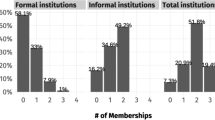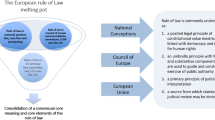Abstract
A rich literature examines human rights treaty commitment and compliance. A subset of this literature has begun to examine the international legal actions states make following treaty ratification. I argue that the ways that states legally engage with treaties following commitment to UN human rights treaties is much more nuanced and differentiated than scholars have thus far presented via Reservation, Understanding, and Declaration. I introduce a first descriptive analysis of what I term Post-Commitment Actions (PCAs) to UN human rights treaties and generate varying hypotheses of why different PCAs have different relationships with expected human rights practices. I conduct a preliminary statistical analysis of the effect of PCAs on human rights practices and find that they are varied and important. Some PCAs result in improved human rights, while others result in worse human rights. I conclude by calling for further future study into these treaty actions.



Similar content being viewed by others
Notes
In this article, I use “ratification” to describe binding commitment to human rights treaties, although I note that accession and succession are similarly binding actions. For the purposes of this article, I am concerned only with the fact states committed via legally binding action to human rights treaties and do not get into the legal distinctions across the types of legally binding commitment.
Throughout this article, I refer to actions as post-commitment actions to denote discussion of all legal actions made following ratification and to distinguish from prior research/arguments/findings that examined a subset of these treaty actions as RUDs (Reservations, Understandings, and Declarations).
Core UN human rights treaties identified by the UN are the ICCPR, CERD, ICESCR, CAT, CEDAW, CRC, CED, CRPD, and CMW
Understandings are dropped from PCA model analysis since only five understandings were made relative to the ICCPR. One understanding came from Argentina and the other four from the USA. When included in the models, STATA drops the variable.
Understandings are included when analyzing RUDs as a collapsed category.
References
Baratta, Roberto, 2000. Should invalid reservations to human rights treaties be disregarded? European Journal of International Law, 11(2), pp.413–425.
Bradley, Curtis A. and Jack L. Goldsmith. 2000. Treaties, Human Rights, and Conditional Consent. University of Pennsylvania Law Review 149(2): 399–468.
Brooke, James. 1989. For Argentina, Inflation and Rage Rise in Tandem. The New York Times. June 4 1989. Accessed at https://www.nytimes.com/1989/06/04/weekinreview/the-world-for-argentina-inflation-and-rage-rise-in-tandem.html
Cole, Wade M. 2005. Sovereignty Relinquished? Explaining Commitment to International Human Rights Covenants, 1966-1999. American Sociological Review 70(3): 472–95.
Cole, Wade M. 2012. Human rights as myth and ceremony? Reevaluating the effectiveness of human rights treaties, 1981–2007. American Journal of Sociology 117(4):1131–71.
Diehl, Paul F. and Charlotte Ku. 2010. The Dynamics of International Law. Cambridge: Cambridge University Press.
Fariss, Christopher J. 2014. Respect for Human Rights has Improved over Time: Modeling the Changing Standard of Accountability. The American Political Science Review. 108(2): 297–318.
Finnemore, Martha and Stephen J. Toope. 2001. Alternatives to “legalization”: Richer Views of Law and Politics. International Organization 55(3): 743–58.
Fisher, Roger. 1981. Improving Compliance with International Law. Charlottesville: University Press of Virginia.
Forsythe, David P. 2000. Human Rights in International Relations. Cambridge: Cambridge University Press.
Goodman, R., 2002. Human rights treaties, invalid reservations, and state consent. American Journal of International Law, 96(3), pp.531–560.
Goodman, Ryan and Derek Jinks. 2003. Measuring the Effects of Human Rights Treaties European Journal of International Law 14(1): 171-83.
Goldsmith, Jack L. and Eric A. Posner. 2005. The Limits of International Law. Oxford: Oxford University Press.
Hafner-Burton, Emilie M. and Kiyoteru Tsutsui. 2007. Justice Lost! The Failure of International Human Rights Law to Matter Where Needed Most. Journal of Peace Research. 44(4): 407–25
Hafner-Burton, Emilie M., Laurence, R. Helfer, and Christopher J. Fariss. 2011. Emergency and Escape: Explaining Derogations from Human Rights Treaties. International Organization 65: 672–707.
Hathaway, Oona A. 2005. Between Power and Principle: An Integrated Theory of International Law. University of Chicago Law Review 72:469–536.
Henkin, Louis. 1995. U.S. Ratification of Human Rights Treaties: The Ghost of Senator Bricker. The American Journal of International Law: 89.
Hill, Daniel W. Jr. 2016. Avoiding Obligation: Reservations to Human Rights Treaties. Journal of Conflict Resolution 60(6): 1129–58.
Human Rights Watch. 1989. Annual Report: Argentina. Available at https://www.hrw.org/reports/1989/WR89/Argentin.htm
ICJ. 1951. Advisory Opinion, 1951 I.C.J. 15.
International Covenant on Civil and Political Rights (ICCPR). 1966. United Nations Treaty Series, vol. 999, p. 171.
Keith, Linda Camp. 1999. The United Nations International Covenant on Civil and Political Rights: Does it Make a Difference in Human Rights Behavior? Journal of Peace Research 36(1):95–118.
Kim, Hunjoon and Kathryn Sikkink. 2010. Explaining the Deterrence Effect of Human Rights Prosecutions for Transitional Countries1. International Studies Quarterly 54(4): 939–963.
Kumar, Akshaya. 2016. A Midlife Crisis for the Treaty-Based Human Rights System? UN Chronicle: The Magazine of the United Nations 52(4). Available online at https://unchronicle.un.org/article/midlife-crisis-treaty-based-human-rights-system
Landman, Todd. 2005. Protecting Human Rights: A Comparative Study. Washington, D.C: Georgetown University Press.
Lijnzaad, Elizabeth. 1995. Reservations to UN Human Rights Treaties: Ratify and Run? Leiden: Martinus Nijhoff Publishers
McKibben, Heather Elko and Shaina D. Western. 2018. “Reserved Ratification”: An Analysis of States’ Entry of Reservations Upon Ratification of Human Rights Treaties. British Journal of Political Science (online first 09 March 2018).
Millington, Ben. 2016. Queensland Prisons Allowing Incarcerated Mothers to Raise Young Children. Australian Broadcasting Corporation. Available at http://www.abc.net.au/news/2016-11-27/children-living-with-mothers-in-queensland-prisons/8060524
Mitchell, Ronald B. 1994. Regime Design Matters: Intentional Oil Pollution and Treaty Compliance. International Organization 48(3): 425.
Neumayer, Eric. 2005. Do International Human Rights Treaties Improve Respect for Human Rights? Journal of Conflict Resolution 49 (6): 925–953
Neumayer, Eric. 2007. Qualified Ratification: Explaining Reservations to International Human Rights Treaties. Journal of Legal Studies 36(2):397–430.
Powell, Emilia Justyna and Jeffrey K. Staton. 2009. Domestic Judicial Institutions and Human Rights Treaty Violation. International Studies Quarterly 53(1): 149–74
Raustiala, Kal and Anne-Marie Slaughter. 2002. International Law, International Relations, and Compliance. In Handbook of International Relations, edited by Walter Carlsnaes, Thomas Risse, and Beth A. Simmons, 538–558. Thousand Oaks, CA: Sage.
Reed, Robert W. 2015. On the Practice of Lagging Variables to Avoid Simultaneity. Oxford Bulletin of Economics and Statistics 77(6): 897–905.
Richards, David L. and K Chad Clay. 2012. An Umbrella with Holes: Respect for Non-Derogable Human Rights During Declared States of Emergency, 1996-2004. Human Rights Review 13(4):443–71.
Schabas, William A., 1995. Invalid Reservations to the International Covenant on Civil and Political Rights: is the United States still a party. Brooklyn Journal of International Law 21(2): 277–325.
Simmons, Beth A. 2009. Mobilizing for Human Rights: International Law in Domestic Politics. Cambridge: Cambridge University Press.
Sloss, David. 2006. Using International Law to Enhance Democracy. Virginia Journal of International Law 47(1): 1–61.
The Economist. 2014. The Tragedy of Argentina: A Century of Decline. February 17 2014. Available at https://www.economist.com/briefing/2014/02/17/a-century-of-decline
United Nations.1969 Vienna Convention on the Law of Treaties, United Nations, Treaty Series,vol. 1155, p. 331, available at: http://www.refworld.org/docid/3ae6b3a10.html [accessed 31 May 2018]
United Nations. 1989. United Nations Treaty Series. Vol. 1532, A-14668. Pg. 351–2 available at https://treaties.un.org/doc/Publication/UNTS/Volume%201535/v1535.pdf.
United Nations. 1996a. United Nations Treaty Series. 1996. Vol. 1927, Pg. 562.
United Nations. 1996b. United Nations Treaty Series. 1996. Vol. 1934, A-24841. Pg. 369.
United Nations. 1999. United Nations Treaty Series. Vol. 2068, A-24841. Pg. 337.
United Nations. 2000. United Nations Treaty Series. 2000. Vol. 1676 pg. 543. Accessible online at https://treaties.un.org/doc/Publication/UNTS/Volume%201676/v1676.pdf
United Nations. 2005. “Reservations” United Nations Institute for Training and Research.
United Nations. 2007. United Nations Treaty Series. 2007. Vol. 2472, A-14668 pg. 112.
United Nations. 2012. Treaty Handbook. Treaty Section of the Office of Legal Affairs. Available at https://treaties.un.org/doc/source/publications/THB/English.pdf
United Nations. 2018a. Peru: Notification to the International Covenant on Civil and Political Rights. Available at https://treaties.un.org/doc/Publication/CN/2018/CN.384.2018-Eng.pdf
United Nations. 2018b. Portugal: Objection to the Declaration Made by Myanmar upon Ratification to the International Covenant on Economic, Social, and Cultural Rights. Available at https://treaties.un.org/doc/Publication/CN/2018/CN.403.2018-Eng.pdf
Vreeland, James Raymond. 2008. Political Institutions and Human Rights: Why Dictatorships enter into the United Nations Convention against Torture. International Organization 62 (1):65–101.
Wallace, Geoffrey P.R. 2014. Martial Law? Military Experience, International Law, and Support for Torture. International Studies Quarterly 58(3): 501–514.
Wohlforth, William C. 1994. Realism and the End of the Cold War. International Security 19(3): 91.
Author information
Authors and Affiliations
Corresponding author
Rights and permissions
About this article
Cite this article
Comstock, A.L. Adjusted Ratification: Post-Commitment Actions to UN Human Rights Treaties. Hum Rights Rev 20, 23–45 (2019). https://doi.org/10.1007/s12142-018-0536-0
Published:
Issue Date:
DOI: https://doi.org/10.1007/s12142-018-0536-0




